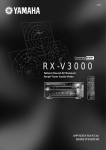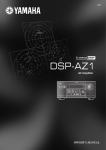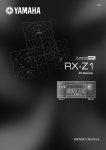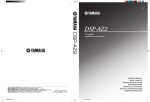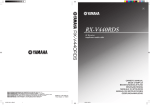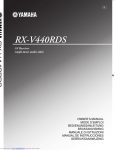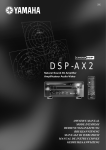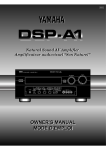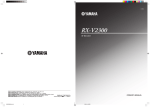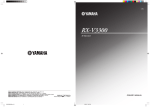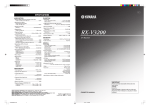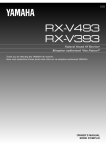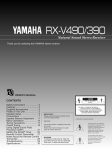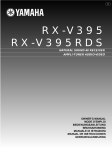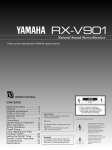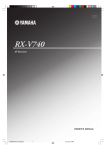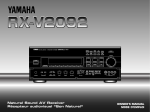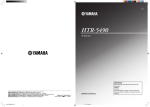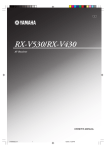Download Yamaha RX-V3000 Receiver
Transcript
UCA RX-V3000 Natural Sound AV Receiver Ampli-Tuner Audio-Video VOLUME INPUT INPUT MODE NATURAL SOUND AV RECEIVER RX–V3000 STANDBY /ON SPEAKERS A B SOURCE /REMOTE DVD D-TV/LD SILENT SAT VCR 1 VCR 2/DVR VIDEO AUX BASS TREBLE EFFECT PRESET /TUNING FM/AM MEMORY TUNING MODE MD/TAPE CD-R TUNER CABLE BASS PROCESSOR EXTENSION DIRECT PHONES CD 6CH PHONO INPUT REC OUT/ZONE 2 EDIT MAN'L/AUTO FM AUTO/NAN'L MONO S VIDEO VIDEO L AUDIO R OPTICAL DSP PROGRAM VIDEO AUX OWNER'S MANUAL MODE D'EMPLOI IMPORTANT SAFETY INSTRUCTIONS 8 Ventilation – The unit should be situated so that its location or CAUTION RISK OF ELECTRIC SHOCK DO NOT OPEN CAUTION: TO REDUCE THE RISK OF ELECTRIC SHOCK, DO NOT REMOVE COVER (OR BACK). NO USER-SERVICEABLE PARTS INSIDE. REFER SERVICING TO QUALIFIED SERVICE PERSONNEL. • Explanation of Graphical Symbols 9 Heat – The unit should be situated away from heat sources such as radiators, stoves, or other appliances that produce heat. 10 Power Sources – The unit should be connected to a power supply only of the type described in the operating instructions or as marked on the unit. The lightning flash with arrowhead symbol, within an equilateral triangle, is intended to alert you to the presence of uninsulated “dangerous voltage” within the product’s enclosure that may be of sufficient magnitude to constitute a risk of electric shock to persons. 11 Power-Cord Protection – Power-supply cords should be routed The exclamation point within an equilateral triangle is intended to alert you to the presence of important operating and maintenance (servicing) instructions in the literature accompanying the appliance. 13 Nonuse Periods – The power cord of the unit should be WARNING TO REDUCE THE RISK OF FIRE OR ELECTRIC SHOCK, DO NOT EXPOSE THIS UNIT TO RAIN OR MOISTURE. 1 Read Instructions – All the safety and operating instructions should be read before the unit is operated. 2 Retain Instructions – The safety and operating instructions should be retained for future reference. 3 Heed Warnings – All warnings on the unit and in the operating instructions should be adhered to. 4 Follow Instructions – All operating and other instructions should be followed. 5 Water and Moisture – The unit should not be used near water – for example, near a bathtub, washbowl, kitchen sink, laundry tub, in a wet basement, or near a swimming pool, etc. 6 Carts and Stands – The unit should be used only with a cart or stand that is recommended by the manufacturer. 6A A unit and cart combination should be moved with care. Quick stops, excessive force, and uneven surfaces may cause the unit and cart combination to overturn. 7 Wall or Ceiling Mounting – The unit should be mounted to a wall or ceiling only as recommended by the manufacturer. CAUTION position does not interfere with its proper ventilation. For example, the unit should not be situated on a bed, sofa, rug, or similar surface, that may block the ventilation openings; or placed in a built-in installation, such as a bookcase or cabinet that may impede the flow of air through the ventilation openings. so that they are not likely to be walked on or pinched by items placed upon or against them, paying particular attention to cords at plugs, convenience receptacles, and the point where they exit from the unit. 12 Cleaning – The unit should be cleaned only as recommended by the manufacturer. unplugged from the outlet when left unused for a long period of time. 14 Object and Liquid Entry – Care should be taken so that objects do not fall into and liquids are not spilled into the inside of the unit. 15 Damage Requiring Service – The unit should be serviced by qualified service personnel when: A. The power-supply cord or the plug has been damaged; or B. Objects have fallen, or liquid has been spilled into the unit; or C. The unit has been exposed to rain; or D. The unit does not appear to operate normally or exhibits a marked change in performance; or E. The unit has been dropped, or the cabinet damaged. 16 Servicing – The user should not attempt to service the unit beyond those means described in the operating instructions. All other servicing should be referred to qualified service personnel. 17 Power Lines – An outdoor antenna should be located away from power lines. 18 Grounding or Polarization – Precautions should be taken so that the grounding or polarization is not defeated. 19 For US customers only: Outdoor Antenna Grounding – If an outside antenna is connected to this unit, be sure the antenna system is grounded so as to provide some protection against voltage surges and built-up static charges. Article 810 of the National Electrical Code, ANSI/NFPA 70, provides information with regard to proper grounding of the mast and supporting structure, grounding of the lead-in wire to an antenna discharge unit, size of grounding conductors, location of antenna discharge unit, connection to grounding electrodes, and requirements for the grounding electrode. Note to CATV system installer: This reminder is provided to call the CATV system installer’s attention to Article 820-40 of the NEC that provides guidelines for proper grounding and, in particular, specifies that the cable ground shall be connected to the grounding system of the building, as close to the point of cable entry as practical. EXAMPLE OF ANTENNA GROUNDING MAST ANTENNA LEAD IN WIRE GROUND CLAMP ANTENNA DISCHARGE UNIT (NEC SECTION 810–20) ELECTRIC SERVICE EQUIPMENT GROUNDING CONDUCTORS (NEC SECTION 810–21) GROUND CLAMPS POWER SERVICE GROUNDING ELECTRODE SYSTEM (NEC ART 250. PART H) NEC – NATIONAL ELECTRICAL CODE FCC INFORMATION (for US customers only) 1. IMPORTANT NOTICE : DO NOT MODIFY THIS UNIT! This product, when installed as indicated in the instructions contained in this manual, meets FCC requirements. Modifications not expressly approved by Yamaha may void your authority, granted by the FCC, to use the product. Compliance with FCC regulations does not guarantee that interference will not occur in all installations. If this product is found to be the source of interference, which can be determined by turning the unit “OFF” and “ON”, please try to eliminate the problem by using one of the following measures: 2. IMPORTANT : When connecting this product to accessories and/or another product use only high quality shielded cables. Cable/s supplied with this product MUST be used. Follow all installation instructions. Failure to follow instructions could void your FCC authorization to use this product in the USA. Relocate either this product or the device that is being affected by the interference. 3. NOTE : This product has been tested and found to comply with the requirements listed in FCC Regulations, Part 15 for Class “B” digital devices. Compliance with these requirements provides a reasonable level of assurance that your use of this product in a residential environment will not result in harmful interference with other electronic devices. This equipment generates/uses radio frequencies and, if not installed and used according to the instructions found in the users manual, may cause interference harmful to the operation of other electronic devices. Utilize power outlets that are on different branch (circuit breaker or fuse) circuits or install AC line filter/s. In the case of radio or TV interference, relocate/reorient the antenna. If the antenna lead-in is 300 ohm ribbon lead, change the lead-in to coaxial type cable. If these corrective measures do not produce satisfactory results, please contact the local retailer authorized to distribute this type of product. If you can not locate the appropriate retailer, please contact Yamaha Electronics Corp., U.S.A. 6660 Orangethorpe Ave, Buena Park, CA 90620. The above statements apply ONLY to those products distributed by Yamaha Corporation of America or its subsidiaries. We Want You Listening For A Lifetime YAMAHA and the Electronic Industries Association’s Consumer Electronics Group want you to get the most out of your equipment by playing it at a safe level. One that lets the sound come through loud and clear without annoying blaring or distortion – and, most importantly, without affecting your sensitive hearing. Since hearing damage from loud sounds is often undetectable until it is too late, YAMAHA and the Electronic Industries Association’s Consumer Electronics Group recommend you to avoid prolonged exposure from excessive volume levels. CAUTION CAUTION: READ THIS BEFORE OPERATING THIS UNIT. 1 To assure the finest performance, please read this manual carefully. Keep it in a safe place for future reference. 2 Install this unit in a well ventilated, cool, dry, clean place with at least 30 cm on the top, 20 cm on the right and left, and 10 cm at the back of this unit for ventilation space — away from direct sunlight, heat sources, vibration, dust, moisture, and/or cold. 3 Locate this unit away from other electrical appliances, motors, or transformers to avoid humming sounds. To prevent fire or electrical shock, do not place this unit where it may get exposed to rain, water, and/or any type of liquid. 4 Do not expose this unit to sudden temperature changes from cold to hot, and do not locate this unit in a environment with high humidity (i.e. a room with a humidifier) to prevent condensation inside this unit, which may cause an electrical shock, fire, damage to this unit, and/or personal injury. 5 On the top of this unit, do not place: – Other components, as they may cause damage and/or discoloration on the surface of this unit. – Burning objects (i.e. candles), as they may cause fire, damage to this unit, and/or personal injury. – Containers with liquid in them, as they may cause electrical shock to the user and/or damage to this unit. 6 Do not cover this unit with a newspaper, tablecloth, curtain, etc. in order not to obstruct heat radiation. If the temperature inside this unit rises, it may cause fire, damage to this unit, and/ or personal injury. 7 Do not plug in this unit to a wall outlet until all connections are complete. 8 Do not operate this unit upside-down. It may overheat, possibly causing damage. 9 Do not use force on switches, knobs, and/or cords. 10 When disconnecting the power cord from the wall outlet, grasp the plug; do not pull the cord. 18 Before moving this unit, press STANDBY/ON to set this unit in the standby mode, and disconnect the AC power plug from the wall outlet. This unit is not disconnected from the AC power source as long as it is connected to the wall outlet, even if this unit itself is turned off. This state is called the standby mode. In this state, this unit is designed to consume a very small quantity of power. FREQUENCY STEP switch (General and China models only) Because the interstation frequency spacing differs in different areas, set FREQUENCY the FREQUENCY STEP switch STEP (located at the rear) according to the FM 50kHz 100kHz frequency spacing in your area. AM 9kHz 10kHz Be sure to change the setting of this switch with the AC supply lead of this unit disconnected from the AC outlet. For CANADIAN CUSTOMERS To prevent electric shock, match wide blade of plug to wide slot and fully insert. This Class B digital apparatus complies with Canadian ICES003. DOLBY D I G I T A L Manufactured under license from Dolby Laboratories. “Dolby”, “AC-3”, “Pro Logic” and the double-D symbol are trademarks of Dolby Laboratories. Confidential Unpublished Works. ©1992-1997 Dolby Laboratories, Inc. All rights reserved. 11 Do not clean this unit with chemical solvents; this might damage the finish. Use a clean, dry cloth. 12 Only the voltage specified on this unit must be used. Using this unit with a higher voltage than specified is dangerous and may cause fire, damage to this unit, and/or personal injury. YAMAHA will not be held responsible for any damage resulting from use of this unit with a voltage other than specified. 13 To prevent damage by lightning, disconnect the power cord from the wall outlet during an electrical storm. 14 Take care of this unit so that no foreign objects and/or liquid drops inside this unit. 15 Do not attempt to modify or fix this unit. Contact qualified YAMAHA service personnel when any service is needed. The cabinet should never be opened for any reasons. 16 When not planning to use this unit for long periods of time (i.e. vacation), disconnect the AC power plug from the wall outlet. 17 Be sure to read the “Troubleshooting” section on common operating errors before concluding that this unit is faulty. CAUTION Manufactured under license from Digital Theater Systems, Inc. US Pat. No. 5,451,942 and other world-wide patents issued and pending. “DTS”, “DTS Digital Surround” and “DTS ES” are trademarks of Digital Theater Systems, Inc. Copyright 1996 Digital Theater Systems, Inc. All Rights Reserved. English Contents Introduction 2 Getting Started .......................................................................................................... 3 Controls and Functions ............................................................................................. 4 Preparations 8 Speaker System Configurations ............................................................................... 9 Hookups ................................................................................................................. 10 On-Screen Displays (OSD) .................................................................................... 19 Speaker Placement ................................................................................................. 20 Speaker Settings ..................................................................................................... 21 Speaker Output Levels ........................................................................................... 22 Basic Operation 24 Basic Playback ....................................................................................................... 25 AM/FM Tuner ........................................................................................................ 29 Basic Recording ..................................................................................................... 33 Advanced Operation 34 SET MENU Items .................................................................................................. 35 Remote Control Features ........................................................................................ 44 ZONE 2 .................................................................................................................. 55 Adjusting the Levels of the Effect Speakers .......................................................... 57 Setting the Sleep Timer .......................................................................................... 57 Additional Information 58 Digital Sound Field Processing (DSP) ................................................................... 59 CINEMA-DSP ....................................................................................................... 61 DSP Parameter ....................................................................................................... 64 Appendix 68 Troubleshooting ..................................................................................................... 69 Specifications ......................................................................................................... 73 1 Introduction Preparations Introduction Basic Operation Welcome to the exciting world of digital home entertainment. This unit is the most complete and advanced AV receiver available. Though some of the more advanced features of this unit may not be familiar to you, they are easy to use. Incorporated state-of-the-art technology such as Dolby Digital and DTS can bring the same audio experience to your home as they have brought to feature films in quality theaters around the world. To make the listening experience even more enjoyable, this unit includes a number of exclusive, digitally created listening environments known as digital sound fields. Choosing a sound field program is like transporting yourself to such venues as an outdoor arena, a European church, or a cozy jazz club. Take some time now to read more about these features and enjoy the new experiences this unit brings to your home theater. Features Dolby Digital and DTS decoder Dolby Digital Matrix 6.1/DTS ES decoder Digital Sound Fields (DSP) Advanced Operation CINEMA-DSP: Dolby Digital + DSP and DTS + DSP Virtual CINEMA DSP and HP CINEMA DSP Multi-function remote control Additional Information Built-in 8-channel power amplifier Getting Started 3 Appendix Checking the Package Contents ............................................................................... 3 Installing Batteries in the Remote Control ............................................................... 3 Using the Remote Control ........................................................................................ 3 Controls and Functions 4 Front Panel ............................................................................................................... 4 Display Indicators .................................................................................................... 5 Rear panel ................................................................................................................. 6 Remote Control ........................................................................................................ 7 2 Getting Started English Checking the Package Contents Check your package to make sure it has the following items. Alkaline Batteries (3) (LR6) R L Side Panel Sticker AM Loop Antenna FM Antenna (Australia and Singapore models only) Quick Reference Card ■ Remote Control ■ TUNER button (TUNER area) ■ CD button (CD area) Infrared window POWER LEARN MACRO CLEAR RE-NAME TRANSMIT STANDBY SYSTEM POWER A DISPLAY SEARCH Skip Search STOP PLAY PAUSE (/Stop) Numeric buttons 1 to 9 (Set 10KEY) MACRO ON/OFF button POWER Input buttons Preset number 1 to 8 6CH INPUT Display Preset group A through E from left. Source selector CLEAR Numeric button +10 Numeric button 0 Preset group A/B/C/D/E LIGHT DISC +/– (Disc Skip) Operational buttons Preset +/– 10 KEY/DSP INDEX (Set 10KEY) Sound program selector/ Numeric buttons ■ MD/TAPE button (MD area) MUTE TV VOL +/–, TV INPUT, and TV MUTE function if you have set up the manufacturer code for the TV Area. ■ CD-R button (CD-R area) VOLUME +/– Operational buttons EFFECT LEVEL ON SCREEN PARAMETER/SET MENU Cursor buttons SLEEP TEST Cover REC/PAUSE POWER REC/PAUSE POWER DISPLAY SEARCH Skip Search STOP PLAY PAUSE DISPLAY SEARCH SOUND Skip Search STOP PLAY PAUSE Numeric buttons 1 to 9 Numeric buttons 1 to 9 Numeric button +10 Numeric button 0 (Set 10KEY) TV VOL +/–, TV INPUT, and TV MUTE function if you have set up the manufacturer code for the TV Area. Remote Control Numeric button +10 Numeric button 0 INDEX (Set 10KEY) TV VOL +/–, TV INPUT, and TV MUTE function if you have set up the manufacturer code for the TV Area. V655120 Quick Reference Guide Power Cord (U.S.A. and Canada models only) Power Cord (Singapore model only) FM Antenna (U.S.A., Canada, China, and General models only) When finding it difficult to fit this unit onto the shelf, remove the side panels after removing the screws tightened on the side panels. Put this sticker to cover the screw holes after tearing off the back side of the sticker. Installing Batteries in the Remote Control Insert the batteries in the correct direction by aligning the + and – marks on the batteries with the polarity illustrations (+ and –) inside the battery compartment. Change the batteries periodically. Do not use old batteries together with new ones. Do not use different types of batteries (such as alkaline and manganese batteries) together. Read the packaging carefully as these different types of batteries may have the same shape and color. ■ About changing batteries Reset button As the batteries wear out, the operating range of the remote control decreases and the TRANSMIT indicator does not flash or its light becomes dim. When you notice any of these conditions, change all of the batteries. Notes: • If the remote control is without batteries for more than 20 minutes, or if worn out batteries remain in the unit, the contents of the memory may be cleared. If the memory is cleared, insert new batteries and reprogram any functions that may have been cleared. • After you insert new batteries, be sure to push RESET in the battery compartment using a ball point pen or similar object before using the remote control. (This does not clear the contents of the memory.) Using the Remote Control The remote control transmits a directional infrared beam. Be sure to aim the remote control directly at the remote control sensor on the main unit to operate. When the sensor is covered or there is a large object between the remote control and the main unit, the sensor cannot receive signals. The sensor may not be able to receive signals properly when it is exposed to direct sunlight or a strong artificial light (such as a fluorescent or strobe light). In this case, change the direction of the light or reposition the main unit to avoid direct lighting. ■ About handling the remote control VOLUME INPUT INPUT MODE NATURAL SOUND AV RECEIVER RX–V3000 STANDBY /ON SPEAKERS A B SOURCE /REMOTE DVD D-TV/LD SILENT SAT VCR 1 VCR 2/DVR VIDEO AUX BASS 30° TREBLE EFFECT FM/AM MEMORY TUNING MODE MD/TAPE CD-R TUNER CABLE BASS PROCESSOR EXTENSION DIRECT PHONES PRESET /TUNING CD 6CH PHONO INPUT REC OUT/ZONE 2 30° EDIT MAN'L/AUTO FM AUTO/NAN'L MONO S VIDEO VIDEO L AUDIO R OPTICAL DSP PROGRAM VIDEO AUX Approximately 6m (20 feet) Handle the remote control with care. Do not spill water or other liquids on the remote control. Do not drop the remote control. Do not leave or store the remote control in the following types of conditions: • high humidity or temperature such as near a heater, stove or bath; or • dusty places; or • in places subject to extremely low temperatures. 3 Introduction Controls and Functions Front Panel When you are not operating the controls behind the front panel door, close the door. To open the door, press gently on the lower part of the panel. 1 q w 0 e MEMORY TUNED STEREO AUTO Preparations 4 BASS P.DIRECT ZONE 2 SLEEP 3 2 7r9 8 63 5 2 1 5 4 VOLUME INPUT INPUT MODE Basic Operation NATURAL SOUND AV RECEIVER RX–V3000 MEMORY TUNED SPEAKERS A B SOURCE /REMOTE DVD D-TV/LD SILENT SAT BASS PROCESSOR EXTENSION DIRECT VCR 1 VCR 2/DVR VIDEO AUX PHONES BASS Advanced Operation 7 68 9 0 TREBLE q EFFECT VCR2/DVR PRESET /TUNING V-AUX FM/AM CD-R TUNER CD PHONO EDIT MEMORY CD 6CH PHONO INPUT S VIDEO 2 Remote Control Sensor 3 INPUT MODE Selects the type of audio signal for the selected source. 4 INPUT selector Selects a source component. 5 VOLUME Controls the output level of all audio channels. This does not affect the REC OUT level. 6 PHONES Outputs audio signals for private listening using headphones. When you connect headphones, no signals are output to the PREOUT jacks or the speakers. VIDEO L AUDIO R OPTICAL DSP PROGRAM VIDEO AUX w e r Turns this unit on (On mode) and off (Standby mode). When you turn on this unit, you will hear a click and there will be a four to five second delay before this unit can reproduce sound. In Standby mode, this unit consumes a small amount of power to be ready to respond to the remote control. TUNING MODE MAN'L/AUTO FM AUTO/NAN'L MONO REC OUT/ZONE 2 1 STANDBY/ON Additional Information MD/TAPE SAT MD/TAPE CD-R TUNER CABLE Appendix DVD CABLE VCR 1 BASS P.DIRECT ZONE 2 SLEEP 4 D-TV/LD STEREO AUTO STANDBY /ON u i y t o 7 SPEAKERS A/B When SPEAKERS A/B is on, these buttons turn on the set of Main speakers connected to the A and/or B terminals on the rear panel. 8 BASS EXTENSION ON/OFF When BASS EXTENSION is on, this feature boosts the bass frequency of the left and right Main channels by +6dB (60Hz) while maintaining overall tonal balance. This boost is useful if you do not use a subwoofer. However, this boost may not be noticeable if the Main speakers are set to “SMALL” and the bass output mode is set to “SWFR.” 9 PROCESSOR DIRECT ON/OFF When PROCESSOR DIRECT is on, BASS, TREBLE, BALANCE, and BASS EXTENSION are bypassed, eliminating any alteration of the original signal. 0 BASS Adjusts the low frequency response for the left and right Main speaker channels. Turn the control to the right to increase the low frequency response and turn the control to the left to decrease the low frequency response. Controls and Functions q TREBLE w REC OUT/ZONE 2 Selects the source you want to direct to the audio/video recorder. e EFFECT Switches the effect speakers (Center, Front Effect, Rear and Rear Center) on and off. If you turn off the output of these speakers using EFFECT, all DTS and Dolby Digital audio signals are directed to the Main left and right channels except for the LFE channel. r 6CH INPUT Switches between 6CH INPUT mode and normal input modes. 6CH INPUT mode takes priority over the source selected with the INPUT selector. You cannot use DSP sound field programs while using an external decoder. t VIDEO AUX Inputs audio and video signals from a portable external source such as a video camera. To reproduce source signals from these jacks, select V-AUX as the input source. To direct this source to the VCR 1 and VCR 2/DVR output jacks, select VIDEO AUX using REC OUT. English Adjusts the high frequency response for the left and right Main channels. Turn the control to the right to increase the high frequency response. y FM/AM Switches the reception band between FM and AM. u Multi jog knob Selects the tuning frequency in the tuning mode. Selects the preset station after pressing PRESET/TUNING to display a colon (:) in the tuning mode. Selects the DSP program after pressing DSP PROGRAM. i MEMORY (MAN’L/AUTO FM) Stores a station in the memory. o TUNING MODE (AUTO/MAN’L MONO) Switches the tuning mode between automatic and manual. To select the automatic tuning mode, press this button so that the AUTO tuning indicator appears in the front panel display (the STEREO indicator also appears if receiving a stereo broadcast). To select the manual tuning mode, press this button so that the AUTO tuning indicator does not appear. Display Indicators 1 Processor indicators When any function of DTS/VIRTUAL/Dolby Digital/Dolby PROLOGIC/DSP/Dolby Digital Matrix 6.1/DTS ES is operating, its indicator lights up. 2 PCM Lights up when this unit is reproducing PCM (Pulse Code Modulation) digital audio signals. 3 SPEAKERS A/B Lights up according to which set of Main speakers is selected. Both indicators light up when both sets of speakers are selected. 4 Headphones Lights up when headphones are connected. 5 Multi-information display Shows the current DSP program and other information when adjusting or changing settings. 6 Input source Shows the current input source with the arrow-shaped cursor. 8 SLEEP Lights up while the Sleep Timer is on. 9 P. DIRECT Lights up while the PROCESSOR DIRECT is on. 0 STEREO Lights up when the AUTO tuning indicator is on and the unit is receiving a strong signal for an FM stereo broadcast. q MEMORY Flashes to show a station can be saved. w TUNED Lights up when this unit tunes into a station. e AUTO Shows that the Tuner is in Automatic tuning mode. r ZONE 2 Lights up when you select the input source while the remote control is in the Zone 2 mode. 7 BASS Lights up while the BASS EXTENSION is on. 5 Controls and Functions Introduction Rear panel 3 2 e 1 7 5 0 TUNER L R OPTICAL R L CAUTION SEE INSTRUCTION MANUAL FOR CORRECT SETTING. AM ANT MD/TAPE – GND R R L FM ANT 75Ω UNBAL. L Preparations REMOTE IMPEDANCE SELECTOR SET BEFORE POWER ON FRONT : 6ΩMIN./SPEAKER REAR : 4ΩMIN./SPEAKER REAR CENTER : 4ΩMIN./SPEAKER : 4ΩMIN./SPEAKER CENTER MAIN A OR B : 4ΩMIN./SPEAKER A + B : 8ΩMIN./SPEAKER FRONT : 8ΩMIN./SPEAKER REAR : 8ΩMIN./SPEAKER REAR CENTER : 8ΩMIN./SPEAKER : 8ΩMIN./SPEAKER CENTER MAIN A OR B : 8ΩMIN./SPEAKER A + B : 16ΩMIN./SPEAKER CENTER ZONE 2 OUT CTRL OUT +5V 100Ω 20mA Basic Operation r q 8t 2 R w L R 9 R L 4 6 9 PRE OUT/MAIN IN jacks 2 Video component jacks 0 AC power cord 4 Speaker terminals 5 AC OUTLETS Use these outlets to supply power to your other audio/video component. 6 IMPEDANCE SELECTOR 7 DIGITAL OPTICAL/COAXIAL jacks 8 6CH INPUT jacks Connect to a power outlet. General, China, and Australia models cannot disconnect the AC power cord from the unit. q GROUND terminal w RS232C/CTRL OUT +5V terminals These are control expansion terminals for Substitute Custom Installation use. Consult your dealer for details. e REMOTE IN/OUT jacks r q RF (AC-3) input jack General, China, and Singapore models only. Appendix Additional Information t ZONE 2 OUT jack 6 (Singapore model) 1 Audio component jacks 3 Antenna input terminals Advanced Operation L Controls and Functions Remote Control 1 2 3 y u English g 9 Operational buttons 4 5 6 k 7 8 i o Performs the operation selected by input selector. 0 Sound program selector/Numeric buttons Selects the sound program. q MUTE Mutes the sound. Press again to restore audio output at the previous volume level. w VOLUME +/– Increases or decreases the volume level. e EFFECT h Switches the effect speakers (Center, Front, Rear, and Rear Center) on and off. r PARAMETER/SET MENU p 0 9 Selects the PARAMETER mode or SET MENU mode. t Cursor buttons q Selects and adjusts DSP program parameters and SET MENU items according to the position of PARAMETER/SET MENU. w e a s d f r t y STANDBY Turns off the power. u SYSTEM POWER Turns on the power. i Display Displays the input or operation status. j o Source selector Selects the source component. p 10 KEY/DSP Selects the numeric button mode or DSP program mode. 1 CLEAR Erases the content of learning. 2 RE-NAME Renames the input name. 3 TRANSMIT Flashes while the remote control is sending signals. 4 LEARN Starts the learning function. 5 MACRO Makes the MACRO setting. 6 MACRO ON/OFF Turns the macro function on and off. 7 Input buttons Selects the input source for playback. 8 6CH INPUT Switches to the 6CH INPUT mode when using an external decoder. a LEVEL Selects the effect speaker channel to be adjusted and sets the level. s ON SCREEN Selects the On-Screen Display mode for your video monitor. d SLEEP Sets the sleep timer. f TEST Outputs the test tone to adjust the speaker levels. g Infrared window h LIGHT Turns the light on or off. When you press this button once, the light turns on for about ten seconds. Press again to turn off the light. j Cover k Å button Switches the control area. 7 Introduction Preparations Basic Operation Advanced Operation Preparations Speaker System Configurations Hookups 9 10 Additional Information Connecting Audio Components ............................................................................. 10 Connecting Video Components ............................................................................. 12 Connecting Speakers .............................................................................................. 14 Connecting Subwoofers ......................................................................................... 16 Connecting an External Decoder ............................................................................ 17 Connecting External Amplifiers ............................................................................. 17 Others ..................................................................................................................... 18 On-Screen Displays (OSD) 19 Appendix OSD Modes ............................................................................................................ 19 Selecting the OSD Mode ........................................................................................ 19 Speaker Placement 20 Speaker Settings 21 Speaker Output Levels 22 Before You Begin ................................................................................................... 22 Dolby Surround Test .............................................................................................. 22 DSP Test ................................................................................................................. 23 8 Speaker System Configurations English The most complete speaker configuration consists of eight speakers: the left and right Main speakers, a Center speaker, the left and right Rear speakers, the left and right Front Effect speakers, and a Rear Center speaker. If you do not use eight speakers, you can direct the signals for speakers that are not in your system to other speakers in your configuration. A Subwoofer can be used with any of these configurations to produce a fuller sound. Front Effect Speakers Rear Speakers Main Speakers Center Speaker Rear Center Speaker Front Subwoofer Rear Subwoofer ■ Eight or Seven Speaker Configuration –Full Cinema DSP– ( ) When you reproduce feature film software, this configuration fully expresses the powerful and realistic sound qualities of 70 mm multitrack audio. The dialogue is positioned as if it were coming from directly on the screen, the sound effect is positioned slightly behind the screen, and the soundtrack music is positioned even further behind the screen to express the width and depth of the overall presentation. This configuration makes the most of this unit’s capability. The Rear Center speaker is useful for playback of 6-channel Digital Surround. ■ Six Speaker Configuration –Hi Fi DSP– This configuration is used the most for audio playback with HiFi DSP. It does not position the dialogue sound as well as a seven or eight speaker configuration. However, it creates a dynamic DSP (Digital Sound Field Processor) sound field which adds depth to the sound. For this speaker configuration, change SET MENU item 1A. CENTER SP to “NONE” and 1D. REAR CT SP to “NONE”. ■ Five Speaker Configuration –Standard 5.1 Channel– This configuration does not express the height of the sound field as well as the seven or eight speaker configuration. However, it positions the dialogue sound as coming directly from the screen. For this speaker configuration, change SET MENU item 1F. FRNT EFCT SP to “NONE” and 1D. REAR CT SP to “NONE”. ■ Four Speaker Configuration –Minimum Requirement– In this configuration, the Center speaker signals and Front Effect speaker signals are directed to the left and right Main speakers. For this speaker configuration, change SET MENU item 1A. CENTER SP to “NONE,” item 1F. FRNT EFCT SP to “NONE,” and item 1D. REAR CT SP to “NONE”. 9 Introduction Hookups Connecting Audio Components Before you connect any components, disconnect the power supply to all the components you plan to connect including this unit and determine which jacks are for the left and right channels and for input and output. When you connect other YAMAHA audio component (such as a CD player or changer, MD deck, or tape deck), connect to terminals with the same number labels. Yamaha applies this labelling system to all its products. In the hookup illustrations on the following pages: ■ Connecting to digital jacks Preparations This unit has digital jacks for direct transmission of digital signals through either coaxial or fiber optic cables. You can use the digital jacks to input PCM, DTS, and Dolby Digital bitstreams. When you connect components to both the COAXIAL and OPTICAL jacks (for CD and CABLE) priority is given to the input signals from the COAXIAL jack. All digital input jacks are acceptable for 96 kHz/24 bit digital signals. ■ About the dust protection cap Basic Operation Pull out the cap from the optical jack before you connect the fiber optic cable. Do not discard the cap. When you are not using the optical jack, be sure to put the cap back in place. This cap protects the jack from dust. The OPTICAL jacks on this unit conform to the EIA standard. If you use a fiber optic cable that does not conform to this standard, this unit may not function properly. ■ Connecting a turntable These jacks are for connecting a turntable with an MM or high output MC cartridge. If you have a turntable with a low output MC cartridge, use an inline boosting transformer or MC-head amplifier when connecting to these jacks. The GND terminal does not electrically ground the turntable. It simply reduces noise in the signal. In some cases, you may hear less noise if you do not connect to the GND terminal. ■ Connecting a CD player Advanced Operation • The COAXIAL CD and OPTICAL CD jacks are available for a CD player which has coaxial or optical digital outputs. • When you connect a CD player to both the COAXIAL CD and OPTICAL CD jacks, priority is given to the input signals from the COAXIAL CD jack. ■ Connecting an MD or DAT deck • When you connect a recorder to this unit, keep the deck’s power on while using this unit. If the power is off, this unit may distort the sound from other component. Additional Information • When you record from source component connected to this unit while this unit’s power is off, the recorded sound may be distorted. To avoid this problem, turn on this unit. Appendix • When you connect a CD recorder to both the analog and digital input and output jacks, priority is given to the digital signals. 10 Hookups English OPTICAL INPUT MD/TAPE recorder INPUT OUTPUT L <Analog> R R L (Singapore model) INPUT L OPTICAL INPUT <Digital> <Analog> R OPTICAL OUTPUT L <Analog> <Digital> OUTPUT CD recorder <Analog> R OPTICAL OUT (REC) <Digital> <Digital> OUT (REC) OPTICAL OUTPUT OPTICAL OUTPUT L <Analog> R CD player COAXIAL OUTPUT <Digital> CENTER ZONE 2 OUT CTRL OUT +5V 100Ω 20mA L OUTPUT <Analog> R Turntable GROUND to/from External Amplifier to/from External Controller from External Decoder 11 Hookups Connecting Video Components Introduction Before you connect any components, disconnect the power supply to all the components you plan to connect including this unit and determine which jacks are for the left and right channels and for input and output. After you finish all hookups, check them again to make sure they are correct. ■ About the video jacks Preparations There are three types of video jacks. Video signals input through the VIDEO jacks are the conventional composite video signals. Video signals input through the S VIDEO jacks are separated into luminance (Y) and color (C) video signals. The S-video signals achieve high quality color reproduction. Video signals input through the COMPONENT VIDEO jacks are separated into luminance (Y) and color difference (PB/CB, PR/CR) video signals. The jacks are also separated into three for each signal. The labels of the component video jacks may be different depending on the component (e.g. Y, CB, CR / Y, PB, PR / Y, B-Y, R-Y/ etc.). Component video signals provide the best quality in picture reproduction. Composite VIDEO jack S VIDEO jack COMPONENT VIDEO jacks If your video component has an S-video output or component video output, you can connect it to this unit. Connect the S-video signal output jack on your video component to the S-VIDEO jack or connect the component signal output jacks on your video component to the COMPONENT VIDEO jacks. Notes: • Each type of video jack works independently. Signals input through the composite video, S-video, and component jacks are output through the corresponding composite video, Svideo, and component jacks respectively. Basic Operation • Use a commercially available S-video cable when connecting to the S VIDEO jacks, and commercially available video cables when connecting to the COMPONENT VIDEO jacks. Appendix Additional Information Advanced Operation • When you are using the COMPONENT VIDEO jacks, check the details in the owner’s manual that came with the component being connected. 12 Hookups English COMPONENT OUTPUT S VIDEO OUTPUT OPTICAL OUTPUT DVD player COMPONENT OUTPUT VIDEO OUTPUT <Video> R <Analog> <Digital> L <Component Video> AUDIO OUTPUT <Component Video> VIDEO OUTPUT <Video> S VIDEO OUTPUT AUDIO OUTPUT OPTICAL OUT (REC) L RF OUTPUT R DTV/LD player OPTICAL OUTPUT <Analog> OUT (REC) <Digital> L <Analog> R AUDIO OUTPUT SAT OPTICAL OUTPUT <Digital> Cable TV/SAT S VIDEO OUTPUT VIDEO OUTPUT <Digital> CABLE COAXIAL OUTPUT CENTER ZONE 2 OUT AUDIO INPUT L <Video> <Video> <Analog> <Video> CTRL OUT +5V 100Ω 20mA <RF> <Analog> RF-Signal Output* (General, China and Singapore models only) <Component Video> <Video> AUDIO OUTPUT R L VIDEO INPUT R S VIDEO OUTPUT S VIDEO INPUT S VIDEO VIDEO OUTPUT INPUT Monitor VCR 1/2 VIDEO INPUT COMPONENT INPUT * <U.S.A., Canada, and Australia models> If your LD player has a Dolby Digital RF signal output jack, connect it to this unit through an external RF demodulator. (You can connect the Dolby Digital RF signal output of your LD player to the COAXIAL jacks using the “I/O ASSIGN” on the SET MENU.) 13 Hookups Connecting Speakers Introduction This section explains how to connect speakers to this unit. After you finish connecting your speakers, use the SET MENU to change the signal output settings according to the number and size of the speakers in your configuration. Before connecting any speaker cords, identify which terminals are for the right and left channels and also the + and – polarities. If you connect speakers with the wrong polarity (+ to –), this unit will not reproduce clear sound. ■ Using speaker cords Preparations A speaker cord is actually a pair of insulated cables running side by side. One of the cables is colored or shaped differently, perhaps with a stripe, groove, or ridge. To make sure you always connect speakers with the correct polarity, determine the difference between the cables of your speaker cord, make a note of which cable you plan to use for which polarity (+ and –), and always connect the speaker cords consistently. 1 Strip off 9 mm (3/8 in.) of an inch of insulation from the ends of the cables. 2 Twist the exposed wires of the cable together to prevent short circuits. 3 Loosen the terminal knob by turning it counterclockwise. Banana Plug 4 Insert only the exposed portion of the cable into the slot in the side of the terminal, and tighten the terminal knob. Note: Basic Operation • If your speaker cords have banana plugs, tighten the terminal knob and insert the plug into the end of the terminal. (Except for Singapore model) Caution: • Connect the speaker cords with care to avoid creating a short circuit. If you turn on the power and there is a short circuit, this unit may be damaged even though the protection circuit automatically shuts off the power. (Except for Singapore model) ■ About the q RF (AC-3) signal input jack <For China, Singapore, and General models only.> If your LD player has an q RF (AC-3) signal output jack, connect it to the q RF (AC-3) input jack on this unit. For this connection, change SET MENU item 7D. COAXIAL IN (10) to “LD-RF”. If q RF (AC-3) and analog signals are input at the same time, priority is given to the RF signals. When you want to reproduce q RF (AC-3) signals, set the input mode to “D.D. RF” using INPUT MODE. Note: Advanced Operation • q RF (AC-3) signals cannot be output using the REC OUT selector. When you record sound or images from an LD player, be sure to connect the player to either the DIGITAL OPTICAL or analog AUDIO jacks. Caution: Appendix Additional Information • Even if you connect an LD player with an q RF (AC-3) output jack to this unit, you cannot reproduce Dolby Digital sound from all LD discs. You must playback an LD disc encoded with Dolby Digital signals in order to take advantage of the Dolby Digital sound. 14 Hookups English Right Front Speaker Left Front Speaker Right Rear Speaker Left Rear Speaker Rear Center Speaker (Singapore model) TUNER CAUTION SEE INSTRUCTION MANUAL FOR CORRECT SETTING. AM ANT – GND FM ANT 75Ω UNBAL. To other component IMPEDANCE SELECTOR SET BEFORE POWER ON FRONT : 6ΩMIN./SPEAKER REAR : 4ΩMIN./SPEAKER REAR CENTER : 4ΩMIN./SPEAKER CENTER : 4ΩMIN./SPEAKER MAIN A OR B : 4ΩMIN./SPEAKER A + B : 8ΩMIN./SPEAKER FRONT : 8ΩMIN./SPEAKER REAR : 8ΩMIN./SPEAKER REAR CENTER : 8ΩMIN./SPEAKER CENTER : 8ΩMIN./SPEAKER MAIN A OR B : 8ΩMIN./SPEAKER A + B : 16ΩMIN./SPEAKER Center Speaker Subwoofer system Right Main B Speaker Left Main B Speaker Right Main A Speaker Left Main A Speaker 15 Hookups Connecting Subwoofers Introduction ■ Connecting a front subwoofer R L Connect the signal input jack on your subwoofer to one of the PRE OUT/ MAIN IN SUBWOOFER jacks. Notes: • The SUBWOOFER jacks (output) have a built-in high cut-off filter (90 Hz). When using a powered subwoofer, set the high cut-off frequency to “MAX” on your Subwoofer. CENTER R • Both SUBWOOFER jacks output the same signal. L Preparations Subwoofer system ■ Connecting a rear subwoofer Subwoofer system By using both Front and Rear Subwoofers, the CINEMA-DSP sound field programs can produce realistic movie effects with powerful, dynamic sound. To take advantage of this dynamic sound, be sure to set the 1C. REAR L/R SP item in the SET MENU to “LARGE”, and connect your Rear speakers and Subwoofer as described below. Basic Operation 1 Connect the right + input terminal on your Subwoofer to the REAR R + terminal, and the right – input terminal on your Subwoofer to the REAR R – terminal with speaker cords. Right Rear Speaker Left Rear Speaker 2 Connect the left + input terminal on your Subwoofer to the REAR L + terminal, and the left – input terminal on your Subwoofer to the REAR L – terminal with speaker cords. 3 Connect your Rear speakers to the output terminals on the Rear Subwoofer. Be sure to connect the Rear speakers to the Subwoofer with the correct polarity. Note: Appendix Additional Information Advanced Operation R 16 L • Adjust the speaker volume for the Subwoofer with the controls on the Subwoofers, not on this unit. Hookups Connecting an External Decoder English This unit is equipped with six additional input jacks (left and right MAIN, CENTER, left and right SURROUND and SUBWOOFER) for discrete multi-channel input from an external decoder, sound processor, or pre-amplifier. Connect the output jacks on your external decoder to the 6CH INPUT jacks. Be sure to match the left and right outputs to the left and right input jacks for the main and surround channels. To listen to the sound from your external decoder, press 6CH INPUT on this unit or the remote control. Notes: • When you select 6CH INPUT as the input source, this unit automatically turns off the digital sound field processor, and you cannot listen to DSP programs. • When you select 6CH INPUT as the input source, changing SPEAKER SET on the SET MENU is not affected. Connecting External Amplifiers If you want to increase the power output to the speakers, or want to use another amplifier, connect an external amplifier to the PRE OUT/ MAIN IN terminals as follows. R r L q w e t CENTER y R q FRONT jacks Front Effect channel line output jacks. w REAR (Surround) jacks Rear channel line output jacks. e SUBWOOFER jacks Main, Center, and Rear channel frequencies below 90 Hz are output through these jacks. You can also direct DTS and Dolby Digital LFE signals to this output. Adjust the volume level of the subwoofer with the control on the subwoofer. Subwoofer volume cannot be adjusted from this unit. L r CENTER jack Center channel line output jack. t REAR CENTER jack Rear Center channel line output jack. y MAIN jacks MAIN IN jacks .......... Line input to this unit’s Main channel amplifiers. When connecting to these jacks, signals input to the preamplifier of this unit will not be output from the main amplifier of this unit. MAIN OUT jacks ..... Main channel line output jacks. The signals output through these jacks are affected by BASS, TREBLE, BALANCE, and BASS EXTENSION settings. 17 Hookups Others Introduction ■ IMPEDANCE SELECTOR switch WARNING Select the position whose requirements your speaker system meets. Preparations Do not change the IMPEDANCE SELECTOR switch setting while the power to this unit is on, otherwise this unit may be damaged. IF THIS UNIT FAILS TO TURN ON WHEN THE STANDBY/ON SWITCH IS PRESSED: The IMPEDANCE SELECTOR switch may not be set to either end. If so, set the switch to either end when this unit is in the standby mode. AC Power Cord (General, China, and Australia models) VOLTAGE SELECTOR (General and China models) (Upper position) FRONT EFFECT: The impedance of each speaker must be 6Ω or higher. <U.S.A. and Canada models> REAR: The impedance of each speaker must be 4Ω or higher. REAR CENTER: The impedance of the speaker must be 4Ω or higher. <Except for U.S.A. and Canada models> REAR: The impedance of each speaker must be 6Ω or higher. REAR CENTER: The impedance of the speaker must be 6Ω or higher. CENTER: The impedance of the speaker must be 4Ω or higher. MAIN: If you use one pair of main speakers, the impedance of each speaker must be 4Ω or higher. If you use two pairs of main speakers, the impedance of each speaker must be 8Ω or higher. Basic Operation G. VOLTAGE SELECTOR 240 (Lower position) IMPEDANCE SELECTOR SET BEFORE POWER ON FRONT : 6ΩMIN./SPEAKER REAR : 4ΩMIN./SPEAKER REAR CENTER : 4ΩMIN./SPEAKER CENTER : 4ΩMIN./SPEAKER MAIN A OR B : 4ΩMIN./SPEAKER A + B : 8ΩMIN./SPEAKER Advanced Operation FRONT : 8ΩMIN./SPEAKER REAR : 8ΩMIN./SPEAKER REAR CENTER : 8ΩMIN./SPEAKER CENTER : 8ΩMIN./SPEAKER MAIN A OR B : 8ΩMIN./SPEAKER A + B : 16ΩMIN./SPEAKER IMPEDANCE SELECTOR switch AC Power Cord (U.S.A., Canada, and Singapore models only) FRONT EFFECT: The impedance of each speaker must be 8Ω or higher. REAR: The impedance of each speaker must be 8Ω or higher. REAR CENTER: The impedance of the speaker must be 8Ω or higher. CENTER: The impedance of the speaker must be 8Ω or higher. MAIN: <Except for Canada model> If you use one pair of main speakers, the impedance of each speaker must be 8Ω or higher. If you use two pairs of main speakers, the impedance of each speaker must be 16Ω or higher. <For Canada model only> The impedance of each speaker must be 8Ω or higher. ■ Connecting the AC power cord Plug in this unit to a wall outlet when all connections are complete. Caution: Additional Information • Do not use other AC power cords than the one provided. (U.S.A., Canada, and Singapore models only) AC OUTLETS R WER ON N./SPEAKER N./SPEAKER N./SPEAKER N./SPEAKER N./SPEAKER N./SPEAKER N./SPEAKER N./SPEAKER N./SPEAKER N./SPEAKER N./SPEAKER IN./SPEAKER ■ AC OUTLETS Use these to connect the power cords from your other components to this unit. The power to the switched outlets is controlled by this unit’s STANDBY/ON (SYSTEM POWER or STANDBY on the remote). These outlets will supply power to any connected unit whenever this unit is turned on. The maximum power (total power consumption of components) that can be connected to AC OUTLETS is 100 W. ■ Voltage selector (General and China models) Appendix The voltage selector on the rear panel of this unit must be set for your local main voltage BEFORE plugging into the AC main supply. 18 On-Screen Displays (OSD) English You can display the operation information for this unit on a video monitor. If you display the SET MENU and DSP sound field program parameter settings on a screen, it is much easier to see the available options and parameters than it is by reading this information on the front panel display. If a video source is being reproduced, the OSD is superimposed over the image. If a video source is not being reproduced (or the source component is set in the standby mode), you can set the OSD to turn on (blue background) or off with “14 DISPLAY SET” on the SET MENU. OSD Modes P01 CONCERT HALL 1 ≥ Europe Hall A INIT.DLY…………30ms ROOM SIZE…………1.0 LIVENESS…………………5 Full Display (ex.) You can change the amount of information the OSD shows. Full Display .......... This mode always shows the sound field program parameter settings on the video monitor. Short Display ........ This mode briefly shows the same contents as the front panel display at the bottom of the screen, then disappears. Display Off ........... This mode briefly shows the “DISPLAY OFF” message at the bottom of the screen, then disappears. Afterwards, no changes to operations appear on the screen except those of the ON SCREEN. Notes: P01 CONCERT HALL 1 Europe Hall A Short Display (ex.) • When you choose the Full Display mode, the INPUT selector, VOLUME, and some other types of operation information are displayed at the bottom of the screen in the same format as the front panel display. • The OSD signal is not output through the REC OUT selector, and will not be recorded with any video signal. • The SET MENU, TEST DOLBY SUR and TEST DSP appear regardless of the OSD mode. Selecting the OSD Mode ON SCREEN 1 When you turn on the power, the video monitor and front panel display shows the level of the main volume for a few seconds and then switches to show the current sound field program. 2 Press ON SCREEN on the remote control repeatedly to change the display mode. The OSD mode changes in the following order: Full Display, Short Display, and Display Off. Notes: • If you choose a video input source that has component connected to both the S VIDEO IN and composite VIDEO IN jacks, and both the S VIDEO OUT and composite VIDEO OUT jacks are connected to a video monitor, the video signal is output to both the S VIDEO OUT and VIDEO OUT jacks. However, the OSD is carried only on the S-video signal. If no video signal is input, the OSD is carried on both the S-video and composite video signals. • If your video monitor is connected only to the COMPONENT VIDEO jacks of this unit, the OSD is not shown. Make sure to connect your video monitor to the COMPONENT VIDEO jack and either VIDEO or S VIDEO jacks if you would like to see the OSD. • Playing back video software that has an anti-copy signal or video signals with a lot of noise may produce unstable images. 19 Speaker Placement Introduction Where you place your speakers has a tremendous effect on how well your system sounds. ■ Placing the Main speakers TV or Video monitor Main Speaker Main Speaker Place the left and right Main speakers an equal distance from the main listening position. If you have a TV or video monitor in your system, the distance of each speaker from each side of the TV or video monitor should be the same. ■ Placing the Center speaker Preparations TV or Video monitor If you have a TV or video monitor in your system, align the front face of the Center speaker with the front face of the monitor. Place the speaker as close to the monitor as possible, such as directly over or under the monitor. If you place the speaker under the monitor, the Front Effect speakers can adjust the height of the sound to correspond with the action on the screen (depending on the listener’s position). If you have a projection screen in your system, place the Center speaker under the screen. Be sure to align the speaker with the center of the screen. Center Speaker 1m 0.5~1m 1.5~3m 0.5~1m 1m (3ft) (1~3ft) (5~15ft) (1~3ft) (3ft) FR L C R Basic Operation FL R RR L RC ■ Placing the Front Effect, Rear, and Rear Center speakers The Front Effect speakers should be placed about 0.5~1m (1~3 feet) outside the Main speakers and in the front of the room. They should be turned toward the main listening position. Place the Rear speakers in the back of the room so they face the main listening position. The Rear speakers can be placed farther apart than the Front Effect speakers. The Front Effect and Rear speakers should be placed about 1.8m (6 feet) above the floor. Once you begin listening to programs, continue to adjust the speaker placement until you obtain a balanced sound from the Main speakers and the Front Effect and Rear speakers. ■ When you use a projection screen 1 Advanced Operation L R 1/4 C Place the speakers as shown in the illustration. The Main speakers should be placed about one-quarter of the way up from the bottom of the screen. Place the Center speaker in the center and directly under the screen. The Center speaker provides precise dialogue localization. When you use a projection screen with your system, the Front Effect speakers provide better effect quality. The CINEMA-DSP sound field programs raise the sound from the Center speaker upward and provide natural sound corresponding with the video images. ■ Placing the Subwoofers Front Effect speakers Rear speakers Additional Information Main speakers 1.8 m (6 feet) Center Speaker Front Subwoofer Rear Center speaker Rear Subwoofer Place the Front Subwoofer near the Main speakers. Turn it slightly toward the center of the room to reduce wall reflections. If you use a Rear Subwoofer, place it behind the main listening position. The placement of the Rear Subwoofer is not critical because of the ultralow frequencies of the sound being reproduced. By adding a high quality Subwoofer to the speaker system configurations shown on page 9, you can enjoy more powerful and realistic movie effects, even if your Main speakers are large. Notes: Appendix • If you use different brands of speakers (with different tonal qualities) in your configuration, the tone of a moving human voice and other types of sound may not shift smoothly. We recommend that you use speakers from the same manufacturer or speakers with the same tonal quality. You can also adjust the output levels and equalization of your effect speakers using the SET MENU. • If you are using small speakers, the addition of a Subwoofer will reinforce the sound effects of movies. 20 Speaker Settings Summary of SPEAKER SET items 1A through 1G Item Description Initial Setting 1A. CENTER SP Selects the Center channel output mode according to the size of the Center speaker. The possible settings are LRG (large), SML (small), and NONE. LRG 1B. MAIN SP Selects the Main channel output mode according to the size of the Main speakers. The possible settings are LARGE and SMALL. LARGE 1C. REAR L/R SP Selects the Rear channel output mode according to the size of the Rear speakers. The possible settings are LRG (large), SML (small), and NONE. LRG 1D. REAR CT SP Selects the Rear Center channel output according to the size of the Rear Center speaker. The possible settings are LRG (large), SML (small), and NONE. LRG 1E. LFE/BASS OUT Selects a speaker for the LFE/Bass signal output. The possible settings are SWFR (subwoofer), MAIN, and BOTH. BOTH 1F. FRNT EFCT SP Selects the Front Effect signal output mode for the Front Effect signals. The possible settings are YES and NONE. YES 1G. MAIN LEVEL Selects the output level for the Main channel signal. The possible settings are Normal and –10 dB. Normal Note: • When you adjust the balance of the output level from the Right and Left Main speakers, use “L/R BALANCE” on the SET MENU. 21 English This unit has seven SPEAKER SET items in the SET MENU that you must set according to the number of speakers in your configuration and their size. The following table summarizes these SPEAKER SET items, and shows the initial settings as well as other possible settings. If the initial settings are not appropriate for your speaker configuration, change the settings in the SET MENU. Speaker Output Levels Introduction This section explains how to set the speaker levels using the test tone. There are two tests; Dolby Surround test and DSP test. Before You Begin 1 Set BASS and TREBLE on the front panel to “0” (the center position) and turn off BASS EXTENSION. BASS TREBLE Preparations 2 Use the remote control for the next three steps. Sit in the main listening position and set PARAMETER/SET MENU on the remote control to PARAMETER. 3 Set 10 KEY/DSP to DSP and press q/DTS SUR. 4 Press TEST to select the test to be performed. Basic Operation Select “TEST DOLBY SUR.” to match the output levels of the Center, Rear Center and Rear Left and Rear Right speakers to the left and right Main speakers. Select “TEST DSP” to match the output levels of the Front Effect speakers to the Main speakers. Dolby Surround Test 1 After the Dolby Surround test is selected, “TEST DOLBY SUR.” appears in the video monitor and in the front display. FL 2 Adjust VOLUME +/– to hear the test tone for each speaker. Make an adjustment so that the output level coming from each speaker is same. FR L C R Advanced Operation • The test tone is produced from the left Main speaker, Center speaker, right Main speaker, Rear Right speaker, Rear Center speaker, and Rear Left speaker in order. The tone lasts for 2.5 seconds each time. • Press and hold h or g to stop the sequence temporarily. R RR L RC TEST DOLBY SUR. Additional Information EFFECT L SUR. Appendix EFFECT L SUR. 22 LEVEL 0dB LEVEL 0dB • Press h or g to select the speaker to be tested. 3 When adjusting is complete, press TEST twice to stop the test tone. You can increase the output levels of the effect channels (Rear Left, Rear Right, Rear Center, and Center) to +10dB. If the output level of the Center, Rear and Rear Center speakers is lower than that from the Main speakers even after you have increased the sound volume level of the Center, Rear, and Rear Center speakers up to +10dB, set the 1G. MAIN LEVEL item to this setting decreases the Main speaker volume level to about one-third the normal level. After you set the 1G. MAIN LEVEL item in the SET MENU to “–10dB,” adjust the levels for the Center, Rear, and Rear Center speakers again. Speaker Output Levels DSP Test English 1 After the dsp test is selected, “TEST DSP” appears on the video monitor and in the front display. TEST DSP MAIN FL 2 Adjust VOLUME +/– to hear the test tone. Make an adjustment so that the output level coming from the Front Effect speakers is the same as that of the Main speakers. FR L C R • The test tone is produced alternately from the Front Effect speakers and Main speakers. The tone is produced for 2.5 seconds each time. R RR L RC TEST DSP 3 Adjust the output level of the Front Effect speakers using + and – so the output level coming from the Front Effect speakers is the same as that of the Main speakers. • The test tone is automatically produced from the Front Effect speakers while you are adjusting the level. EFFECT FRONT EFFECT FRONT LEVEL 0dB LEVEL 0dB Notes: • If you cannot hear the test tone, set VOLUME, turn off the power, and check the speaker cords and hookups. • The test tone can be reproduced separately from the left and right Front Effect speakers. This is useful when you want to check the hookups to these speakers. Press h to reproduce the test tone from the left speaker, and press g to reproduce the tone from the right speaker. (The OSD shows which speaker is reproducing the tone.) • You cannot adjust the output level of the left and right Front Effect speakers separately. • You can hear the test tone only from the Right Front Effect speaker by pressing g and the Left Front Effect speaker by pressing h. You can return to the original mode by releasing the buttons. • The tonal quality of the speakers can be adjusted using the 5. CENTER GEQ items in the SET MENU. • If the sound volume of the Front Effect speakers is lower than that of the Main speakers, even after you have increased the output level up to +10 dB, set the 1G. MAIN LEVEL item in the SET MENU to “–10dB.” Setting the 1G. MAIN LEVEL item to “–10dB” decreases the Main speaker output level to about one-third of the normal level. After you set the 1G. MAIN LEVEL item in the SET MENU to “–10dB,” repeat the TEST DOLBY SUR. procedure on the previous page. • If you do not use Front Effect speakers, set the 1F FRNT EFCT SP item in the SET MENU to “NONE”, and the DSP Front Effect signals will be mixed with the Main channel signals. • When the headphones are connected to this unit, you cannot select the Dolby Surround test and the dsp test. 23 Introduction Preparations Basic Operation Additional Information Advanced Operation Basic Operation Basic Playback 25 Power Control ........................................................................................................ 25 Selecting a Source .................................................................................................. 26 Input Modes and Indications .................................................................................. 27 Selecting a Sound Field Program ........................................................................... 28 AM/FM Tuner 29 Appendix Connecting the Antennas ....................................................................................... 29 Automatic Tuning .................................................................................................. 30 Tuning to Preset Stations ........................................................................................ 30 Presetting Stations .................................................................................................. 31 Exchanging Preset Stations .................................................................................... 32 Basic Recording 33 Preparations ............................................................................................................ 33 24 Basic Playback English Playback operation is described with buttons on this unit and the remote control. These button names are noted in the order of “button name (remote control button name).” EFFECT STANDBY SYSTEM POWER STANDBY/ON INPUT selector VOLUME INPUT MODE VOLUME INPUT INPUT MODE NATURAL SOUND AV RECEIVER RX–V3000 Input buttons STANDBY /ON SPEAKERS A B SOURCE /REMOTE DVD D-TV/LD SILENT SAT BASS PROCESSOR EXTENSION DIRECT VCR 1 VCR 2/DVR VIDEO AUX PHONES BASS TREBLE EFFECT PRESET /TUNING FM/AM MEMORY TUNING MODE MD/TAPE CD-R TUNER CABLE CD 6CH PHONO INPUT REC OUT/ZONE 2 EDIT MAN'L/AUTO FM AUTO/NAN'L MONO S VIDEO VIDEO L AUDIO R OPTICAL DSP PROGRAM VIDEO AUX VOLUME EFFECT Power Control STANDBY /ON STANDBY /ON 1 Press STANDBY/ON (or SYSTEM POWER on the remote control) to turn on the power. • The front panel (and the monitor screen) shows the level of the volume for a few seconds and then switches to show the current sound field program. 2 Press STANDBY/ON (or STANDBY on the remote control) to turn off the power. Note: • This unit stores its current operational status in memory before the power is turned off. By connecting a commercially available timer to this unit, you can easily playback or record a source at any time you wish. 25 Basic Playback Introduction Selecting a Source 1 Select the source using the INPUT selector, or press one of the input buttons on the remote control. INPUT • The current source is indicated on the front panel display with an arrow. The selected source D-TV/LD DVD CABLE MD/TAPE SAT VCR 1 VCR2/DVR Preparations V-AUX CD-R TUNER CD PHONO • The current source name and input mode appear on the front panel display and the video monitor for a few seconds. Select this source: To reproduce the signal from this component. DVD ........................................ DVD player D-TV/LD ................................ LD player/Digital TV or TV CABLE ................................... Cable TV VCR 1 ..................................... Video deck 1 VCR 2/DVR ........................... Video deck 2 or Digital Video Recorder V-AUX ................................... Other AV component PHONO .................................. Turntable CD ........................................... CD player TUNER ................................... AM/FM tuner MD/TAPE ............................... MD recorder/TAPE deck CD-R ....................................... CD Recorder SAT ......................................... Satellite tuner Basic Operation 2 Start playback (or select a broadcast station) on the source component. • Refer to the operation instructions for the component. VOLUME 3 Adjust VOLUME (or VOLUME +/– on the remote control). Caution: Advanced Operation • If the power of the component connected to the VCR 1, VCR 2/DVR, MD/TAPE, and CD-R OUT jacks is turned off, reproduced sound may be distorted or the volume may be lowered. In these cases, turn on the component. Additional Information ■ BGV (Back Ground Video) function The BGV (Back Ground Video) function allows you to combine a video signal from a video source with a sound signal from an audio source. (For example, you can listen to classical music while you are watching a video.) Appendix Using the remote control, select a source from the video group, then select a source from the audio group. Use the input buttons on the remote control to make your selections. The BGV function does not work if you select the sources using the INPUT selector on the front panel. 26 Basic Playback Input Modes and Indications AUTO:--• DTS DTS DTS:--• ANALOG ANALOG ANALOG:--- <When LD is selected as the input source> (General, China, and Singapore models only) AUTO: ........... In this mode, this unit automatically selects the signal in the following order. 1) Dolby Digital RF encoded signals 2) DTS encoded signals 3) Digital (PCM) signals 4) Analog signals D.D. RF: ........ This unit only selects Dolby Digital RF signals. DTS: .............. In this mode, only digital input signals encoded with DTS are selected even if other signals are input at the same time. DGTL: ........... This unit only selects digital signals input through the OPTICAL jacks. ANALOG: ..... This unit only selects signals input through the ANALOG jacks. This unit will not select Dolby Digital RF or DTS signals. Notes: • If digital signals are input from both the COAXIAL and OPTICAL jacks, the digital signal from the COAXIAL jack is selected. • When AUTO is selected, this unit automatically determines the type of signal. If this unit detects a Dolby Digital or DTS signal, the decoder automatically switches to the appropriate setting and reproduces 5.1 channel source. • The sound output may be interrupted for some LD and DVD players in the following situation: The input mode is set to AUTO. A search is performed while playing the disc encoded with Dolby Digital or DTS, and then disc playing is restored. The sound output is interrupted for a moment because the digital signal was selected again. ■ Notes on playing a source encoded with a DTS signal • If the digital output data of the player has been processed in any way, you may not be able to perform DTS decoding even if you make a digital connection between this unit and the player. • If you play a source encoded with a DTS signal and set the input mode to ANALOG, this unit reproduces the noise of an unprocessed DTS signal. When you want to play a DTS source, be sure to connect the source to a digital input jack and set the input mode to AUTO or DTS. • If you switch the input mode to ANALOG while playing a source encoded with a DTS signal, this unit reproduces no sound. • If you play a source encoded with a DTS signal and set the input mode to AUTO, there will be a moment of noise while the unit recognizes the DTS signal and turns on the DTS decoder. This is not a malfunction. You can avoid this by setting the input mode to DTS beforehand. • If you continue to play a source encoded with a DTS signal with the input mode setting left to AUTO, this unit automatically switches to the “DTS-decoding” mode to prevent noise from being generated during subsequent operation. (The “t” indicator lights up on the front panel display.) The “t” indicator will flash immediately after playback of a source encoded with a DTS signal has finished. Only a source encoded with a DTS signal can be played back while this indicator is flashing. If you want to play a normal PCM source soon, set the input mode back to AUTO. • The “t” indicator will flash when the input mode is set to AUTO and a search or skip operation is performed while playing back a source encoded with a DTS signal. If this status continues for 30 or more seconds, the unit will automatically switch from the “DTSdecoding” mode to PCM digital signal input mode and the “t” indicator will go out. ■ Notes on playing an LD or DTS CD source • For LD software that does not contain a digital soundtrack, connect the LD player to the analog jacks and set the input mode to AUTO or ANALOG. • If the LD player is transmitting a signal by a non-standard method, this unit cannot detect the Dolby Digital or DTS signal. In this case, the decoder automatically switches to PCM or analog. • Some A/V components such as LD players output different audio signals through their analog and digital jacks. Change the input mode as necessary. • While you are operating the LD player and playing a disc encoded with a Dolby Digital signal, if you switch from the pause or chapter forwarding function to normal playback, you may hear the PCM or analog sound an instant before the Dolby Digital signal is played. 27 English This unit comes with various input jacks. If your external component is connected to more than one type of input jack, you can set the priority of the input signal. Press INPUT MODE on the front panel or an input button (press it repeatedly) on the remote control to display or change the input mode. AUTO: ........... This mode is automatically selected when you turn on the power of • AUTO this unit. In this mode, the input signal is automatically selected in the following order. AUTO:DOLBY D. 1) Dolby Digital or DTS encoded signals 2) Digital (PCM) signals AUTO:DTS 3) Analog signals DTS: .............. In this mode, only digital input signals encoded with DTS are selected AUTO:PCM even if other signals are input at the same time. ANALOG: ..... In this mode, only analog input signals are selected even if digital AUTO:ANALOG signals are input at the same time. Basic Playback Selecting a Sound Field Program Introduction You can enhance your listening experience by selecting a DSP sound field program. The 25 DSP sound field programs are divided into 12 DSP program groups. 10KEY/DSP 1 Set 10KEY/DSP on the remote to DSP. 2 Press the DSP button on main unit and rotate the Multi jog knob to select the desired sound field program. Notes: Preparations • If a DTS or Dolby Digital signal is input when the input mode is set to “AUTO”, the sound field program automatically switches to the appropriate decoding program. • Choose a sound field program based on your listening preference, not on the name of the program. The acoustics of your listening room affect the sound field program. Minimize the sound reflections in your room to maximize the effect created by the program. 6.1/ES If you want to utilize the Rear Center speaker with a 5.1 channel program source, press 6.1/ ES. • When you select an input source, the main unit automatically selects the last sound field program used with that source. • When you turn off the main unit, the current source and sound field program are memorized and are automatically selected when you turn on the power again. • When high rate 96 kHz sampling digital signals are output from source equipment, the DSP sound field cannot operate on the source sounds. In this case, the sounds are reproduced as normal 2-channel stereo. Basic Operation Hi-Fi DSP Programs Concert Hall 1 Concert Hall 2 Church Jazz Club Rock Concert Stadium Entertainment Europe Hall A Europe Hall B U.S.A. Hall C Live Concert Freiburg Royaumont Village Gate The Bottom Line Roxy Theatre Arena Anaheim Bowl Disco 8ch Stereo CINEMA-DSP Programs Entertainment Concert Video TV Theater Movie Theater 1 Movie Theater 2 q/DTS SURROUND Game Pop/Rock Classical/Opera Mono Movie Variety/Sports Spectacle Sci-Fi Adventure General Normal/Matrix 6.1/ES Enhanced/6.1/ES ■ Virtual CINEMA DSP and HP CINEMA DSP Advanced Operation You can experience the virtual CINEMA DSP sound field by setting the 1C. REAR L/R SP item in the SET MENU to “NONE.” The sound field processing is changed to the Virtual CINEMA DSP mode according to the selected sound field program. The Virtual CINEMA DSP allows you to enjoy the virtual sound fields without Rear speakers. Signals for Rear channels are output from the Main speakers. You can also listen to HP (Headphone) CINEMA DSP by connecting your headphones to the PHONES jack while the DSP sound fields are on. When high rate 96 kHz sampling digital signals are output from source component, the Virtual CINEMA DSP and HP CINEMA DSP cannot operate on the source sounds. Note: Additional Information • This unit is not set in the virtual CINEMA DSP mode even if “1C REAR L/R SP” is set to NONE in the following cases: – when the 8ch Stereo, DOLBY DIGITAL/Normal or DTS/Normal program is selected; – when the sound effect is turned off; – when 6CH INPUT is selected as the input source; – when 96-kHz sampling digital signals are input to this unit; – when the Dolby Digital KARAOKE source is played; – when using the test tone; or – when connecting the headphones. EFFECT ■ Normal stereo reproduction For normal stereo reproduction, press EFFECT to turn off the effect. EFFECT OFF Notes: • When you turn off the effect, no sound is reproduced from the Front Effect, Center, Rear, and Rear Center speakers. Appendix • If you turn off the effect while DTS or Dolby Digital signals are being reproduced, the dynamic range of the signal is automatically compressed. • The sound volume may be extremely reduced when you turn off the effect or if you change a SET MENU item. In this case turn on the effect. 28 AM/FM Tuner Both AM and FM indoor antennas are included with this unit. These antennas should provide sufficient signal strength in most situations. However, a properly installed outdoor antenna provides clearer reception. If you experience poor reception quality using the indoor antennas, an outdoor antenna may improve the reception. Connect each antenna as shown below. Indoor FM antenna (included) AM loop antenna (included) ■ Connecting the indoor FM antenna Connect the included indoor antenna to the 75Ω UNBAL. FM ANT terminal. ■ Optional outdoor FM/AM antenna Consult your dealer or authorized service center about the best method of selecting and erecting outdoor antennas. TUNER CAUTION SEE INSTRUCTION MANUAL FOR AM ANT – GND R FM ANT 75Ω UNBAL. L L L R R Ground ■ Connecting the AM loop antenna 1 3 1 Press the tab to unlock the terminal hole. 2 Insert the AM loop antenna lead wires to the AM ANT and GND terminals. 3 Lift the tab to its original position to lock the lead wires. 2 Lightly pull on the lead wires to confirm a good connection. 4 Attach the loop antenna to the antenna stand. 5 Orient the AM loop antenna so that the best reception is obtained. Notes: Loop Antenna • The AM loop antenna should be placed away from this unit. The antenna may be hung on a wall. • The AM loop antenna should remain connected, even if an outdoor AM antenna is connected to this unit. • To minimize the influence of automobile ignition noise, locate the antenna as far from heavy traffic as possible. • Keep the ribbon cable or coaxial cable as short as possible. Do not bundle or roll up excess cable. Antenna stand • The antenna should be at least 1.8m (6 feet) from reinforced concrete walls and metallic structures. 29 English Connecting the Antennas AM/FM Tuner Introduction Automatic Tuning 1 Select “TUNER” as the input source. You can use the INPUT selector on the main unit or the input button on the remote control. FM/AM 2 Press AM/FM to select the reception band. FM AM or 3 Press TUNING MODE so that the AUTO tuning indicator appears in the display. TUNING MODE AUTO AUTO/NAN'L MONO Preparations “FM” or “AM” appears in the display. If the colon (:) appears in the display next to the AM or FM indicator, press PRESET/TUNING to turn it off. Turn this indicator off. :FM 89. Turn the Multi jog knob clockwise to tune to a higher frequency or counterclockwise to tune to a lower frequency. Use manual tuning if the tuning search does not stop at the correct station because the signals are weak. Basic Operation A 4 Turn the Multi jog knob clockwise or counterclockwise to start automatic tuning. ■ For manual tuning 1 Press TUNING MODE so that the AUTO tuning indicator goes off in the display. If the colon (:) appears in the display next to the AM or FM indicator, press PRESET/TUNING to turn it off. 2 Turn the Multi jog knob clockwise or counterclockwise to tune to the desired station manually. Hold on the knob to continue the tuning search. Advanced Operation Automatic tuning is effective when the radio signals are strong and have no interference. However, manual tuning is best for weaker signals that have some interference. Note: • Manually selecting an FM station will automatically change the reception to monaural to increase the signal quality. Tuning to Preset Stations Additional Information PRESET /TUNING EDIT A :FM 1 Press PRESET/TUNING so that the colon (:) appears next to the AM or FM indicator. The colon (:) must appear in the display to recall preset stations. If necessary, press PRESET/TUNING again. Appendix 2 Turn the Multi jog knob clockwise or counterclockwise to select the desired preset station number. 30 A1—A2 A8—B1 E8—E7 C1—B8 The preset number appears in the display along with the band, frequency and signal strength information. AM/FM Tuner Presetting Stations English ■ Automatically presetting stations You can use the Automatic Preset Tuning feature to store FM stations. With this function, the unit automatically tunes to FM stations with strong signals, then stores up to 40 of those stations in order. 1 Tune to the FM station from which you want automatic presetting to begin. 2 Press and hold MEMORY for more than 3 seconds. MEMORY The preset number and the MEMORY and AUTO tuning indicators flash. Then, after about five seconds, automatic preset tuning begins. When Automatic Preset Tuning is complete, the display shows the frequency of the last preset station. MAN'L/AUTO FM A-1:FM 89.0 MHz MEMORY D-TV/LD CABLE STEREO AUTO SAT VCR 1 VCR2/DVR V-AUX DVD MD/TAPE CD-R TUNER Automatic Preset Tuning Options CD PHONO Before Automatic Preset Tuning begins (within about five seconds), you can set the preset number from which the unit will store FM stations and the direction in which the unit will scan for stations. 1 Press PRESET/TUNING to display the colon (:). Then turn the Multi jog knob to select the preset station number where the first station will be stored. The unit will stop storing stations if it reaches preset number E8. 2 Press PRESET/TUNING to turn off the colon (:). Then turn the Multi jog knob counterclockwise to scan for lower frequency stations or clockwise to scan for higher frequency stations. If you do not turn either direction before Automatic Preset Tuning begins, the unit will scan for higher frequency stations. Notes: • You can replace a preset station with another FM or AM station manually by simply following the procedure of the section “Manually presetting stations”. • If the number of received stations does not reach to E8, the search finishes automatically after searching all frequencies. • With this function, only FM stations with sufficient signal strength are stored automatically. If the station you want to program is weak in signal strength, tune to it in monaural mode manually, then program it by following the procedure in “Manually presetting stations”. ■ Manually presetting stations This unit can store up to 40 stations (8 stations x 5 groups). Using this feature, you can easily tune to any preset station by selecting the preset station number. 1 Tune to a station. MEMORY 2 Press MEMORY (MAN’L/AUTO FM). MEMORY MAN'L/AUTO FM The MEMORY indicator flashes for about five seconds. 3 Turn the Multi jog knob clockwise or counterclockwise to select a preset station number. Note: • You must select a preset station number before the MEMORY indicator goes off (about five seconds). 31 AM/FM Tuner 4 Press MEMORY (MAN’L/AUTO FM). MEMORY The station band and frequency appear in the display with the preset group and number you selected. Introduction MAN'L/AUTO FM 5 Repeat steps 1 through 4 to store other stations. Shows the displayed station has been programmed to A-1. MEMORY A-1:FM 89.0 MHz D-TV/LD CABLE STEREO SAT VCR 1 VCR2/DVR V-AUX You can store up to 40 stations (A1~A8, B1~B8, C1~C8, D1~D8, and E1~E8). DVD MD/TAPE CD-R TUNER CD PHONO Preparations Exchanging Preset Stations You can exchange the stations stored on two preset numbers. The example below describes the procedure for exchanging the stored stations at preset numbers E1 and A5. 1 Tune to the E1 preset station number. See “Tuning to Preset Stations.” PRESET /TUNING 2 Press and hold PRESET/TUNING (EDIT) for more than 3 seconds. E-1:FM Basic Operation “E-1” flashes in the display. EDIT 3 Tune to the A5 preset station number. A-5:FM See “Tuning to Preset Stations.” A-5 flashes in the display. PRESET /TUNING 4 Press PRESET/TUNING (EDIT) again. The stations stored at the two preset locations are exchanged. EDIT Notes: • The memory back-up circuit prevents the stored data from being lost even if this unit is set to standby mode, the power cord is disconnected from the AC outlet, or power service is temporarily cut due to power failure. However, if the power is cut for more than one week, the memory may be deleted. Advanced Operation Shows the exchange of stations is completed. EDIT Appendix Additional Information 32 E1-A5 D-TV/LD CABLE STEREO AUTO SAT VCR 1 VCR2/DVR V-AUX DVD • Any stored station data existing at a preset number is cleared when you store a new station at that preset number. MD/TAPE CD-R TUNER CD PHONO • The reception mode (stereo or monaural) is stored along with the station frequency. Basic Recording English REC OUT allows you to record one source while viewing and/or listening to another source. Preparations 1 Turn on the power to this unit and all connected component. STANDBY /ON DVD D-TV/LD SOURCE /REMOTE 2 Select the source component you want to record using REC OUT. MD/TAPE CD-R TUNER CABLE SAT CD VCR 1 VCR 2/DVR VIDEO AUX REC OUT PHONO • To record the current source, set REC OUT to SOURCE/REMOTE. • To record a source that you do not want to reproduce, set REC OUT to the source you want to record. 3 Start playback (or select a broadcast station) on the source component. 4 Start recording on the recording component. • If you want to listen to another source, and REC OUT is not set to SOURCE/REMOTE, select the source you want to reproduce with the INPUT selector and adjust the volume. Notes: • Do a test recording before you start an actual recording. • When this unit’s power is off, you cannot record between other component connected to this unit. • Operating BASS and TREBLE, BASS EXTENSION, BALANCE, VOLUME, and DSP programs do not affect the recorded signal. ■ Special considerations when recording DTS software The DTS signal is a digital bitstream. Attempting to digitally record the DTS bitstream will result in noise being recorded. Therefore, if you want to use this unit to record sources that have DTS signals recorded on them, the following considerations need to be made. For DTS encoded LDs, DVDs, and CDs: Only 2-channel analog audio signals may be recorded as follows: • LDs: Set your Laser Disc player’s left and right outputs to the analog soundtrack. • DVDs: Use the disc menu to set the DVD player’s mixed 2-channel left and right audio outputs to the PCM or Dolby Digital soundtrack. • CDs: The DTS signal recorded on CDs can only be output as a digital bitstream, and therefore cannot be recorded. 33 Introduction Preparations Basic Operation Advanced Operation SET MENU Items 35 Additional Information Advanced Operation Operating the SET MENU ..................................................................................... 36 1. SPEAKER SET (1A. CENTER SP to 1G. MAIN LEVEL) .............................. 37 2. LOW FREQ. TEST ............................................................................................ 39 3. L/R BALANCE .................................................................................................. 40 4. HP TONE CTRL (Headphone Tone Control) .................................................... 40 5. CENTER GEQ (Center Graphic Equalizer) ....................................................... 40 6. INPUT RENAME .............................................................................................. 40 7. I/O ASSIGN ....................................................................................................... 41 8. INPUT MODE ................................................................................................... 41 9. PARAMETER INI (Parameter Initialization) .................................................... 41 10. DOLBY D. SET (Dolby Digital Set) ............................................................... 42 11. DTS SET .......................................................................................................... 42 12. 6.1/ES AUTO ................................................................................................... 42 13. SP DELAY TIME ............................................................................................ 43 14. DISPLAY SET ................................................................................................. 43 15. MEMORY GUARD ......................................................................................... 43 16. ZONE 2 SET .................................................................................................... 43 Remote Control Features 44 Using the Remote Control ...................................................................................... 44 Each Component Control Area .............................................................................. 46 Setting the Manufacturer Code in the Remote Control .......................................... 49 Programming a New Remote Control Function ..................................................... 50 Using the Macro Feature ........................................................................................ 51 Changing the Source Name in the Display Window .............................................. 53 Clearing a Learned Function or Macro .................................................................. 53 Clearing Learned Functions and Setups ................................................................. 54 Appendix ZONE 2 55 Connections ............................................................................................................ 55 Remote Control in Zone 2 ...................................................................................... 56 34 Adjusting the Levels of the Effect Speakers 57 Setting the Sleep Timer 57 SET MENU Items English The SET MENU consists of sixteen items including the Speaker Set, Center Graphic Equalizer and Parameter Initialization features. Choose the appropriate item and adjust or select the values as necessary. Notes: • You can adjust the items in the SET MENU while reproducing a source. • We recommend that you adjust the items in the SET MENU while using a video monitor. It is easier to see the video monitor screen than it is to see the front panel display on this unit while adjusting SET MENU items. Descriptions Items Setting Page 1. SPEAKER SET 1A. CENTER SP 1B. MAIN SP 1C. REAR L/R SP 1D. REAR CT SP 1E. LFE/BASS OUT 1F. FRNT EFCT SP 1G. MAIN LEVEL Selects the output mode suitable for your Center speaker. Selects the output mode suitable for your Main speakers. Selects the output mode suitable for your Rear speakers. Selects the output mode suitable for your Rear Center speaker. Selects the output mode for LFE/BASS signal output. Selects the output mode suitable for your Front Effect speakers. Selects the output level for your Main channels. LRG / SML / NONE LARGE / SMALL LRG / SML / NONE LRG / SML / NONE SWFR / MAIN / BOTH YES / NONE Normal / –10dB 2. LOW FREQ. TEST Matches the Subwoofer level with the level of the other speakers. TEST TONE; OFF / ON OUTPUT; MAIN L/R, MAIN L, CENTER, MAIN R, R SUR, REAR CT, L SUR, SWFR, FRONT FREQ.; 35Hz—250Hz (Wide or narrow band) 39 3. L/R BALANCE Adjusts the sound balance for Left and Right channels. L to 0 to R 40 4. HP TONE CTRL Adjusts the tonal balance of the headphones. BASS; –6dB to +3dB TRBL; –6dB to +3dB 40 5. CENTER GEQ Matches the Center speaker tonal quality with the Main speakers. 5-band; –6dB to +6dB 40 6. INPUT RENAME Changes the name of the inputs. Up to eight characters. 40 7. I/O ASSIGN Assigns the I/O terminals to the designated input sources. Digital I/O, CMPNT input. 41 8. INPUT MODE Selects the initial input mode of the sources. AUTO / LAST 41 9. PARAMETER INI Initializes the parameters of a group of DSP programs. 1 to 12 41 10. DOLBY D. SET 10A. LFE LEVEL 10B. D-RANGE Adjusts the output level of the LFE channel for Dolby Digital signals. Adjusts the dynamic range for Dolby Digital signals. SP, HP; –20dB to 0dB SP, HP; MAX / STD / MIN 42 11. DTS SET Adjusts the output level of the LFE channel for DTS signals. SP, HP; –10dB to +10dB 42 12. 6.1/ES AUTO Selects the AUTO mode of Dolby Digital Matrix 6.1 and DTS ES decoding. ON / OFF 42 13. SP DELAY TIME Adjusts the delay time for Center and Rear Center speakers. CENTER; 0ms to 5ms REAR CNTR; 0ms to 30ms 43 14. DISPLAY SET Selects the display settings. BLUE BACK; AUTO/OFF OSD SHIFT; 0 to 10 DIMMER; –4 to 0 43 15. MEMORY GUARD Locks DSP program parameters and other SET MENU settings. OFF / ON 43 16. ZONE 2 SET Selects the mode of Zone 2. ZONE2 OUT; FIXED / VAR. (variable) 43 37–39 35 SET MENU Items Operating the SET MENU Introduction Adjustment should be performed with the remote control. Some items require extra steps to change to the desired setting. PARAMETER / SET MENU Preparations Cursor buttons 1 Set PARAMETER/SET MENU to SET MENU. 2 Press h or g repeatedly to select an item from the table of SET MENU, then press + or – to enter the setting of that item. Basic Operation • The last item you adjusted appears on the display. • Some items have sub items. OSD (On Screen Display) SET MENU 1/4 1 ≥ 2 3 4 SPEAKER SET LOW FREQ.TEST L/R BALANCE HP TONE CTRL Front Panel Display 2 LOW FREQ.TEST -/+ : Enter Advanced Operation 3 Press + or – to change the setting of the item. 2 LOW FREQ.TEST ≥ TEST TONE………OFF OUTPUT…MAIN L/R FREQ.………………88Hz 2 LOW FREQ.TEST TEST TONE………OFF Additional Information 4 Press h or g repeatedly or a DSP program button to exit the SET MENU. Appendix or 36








































